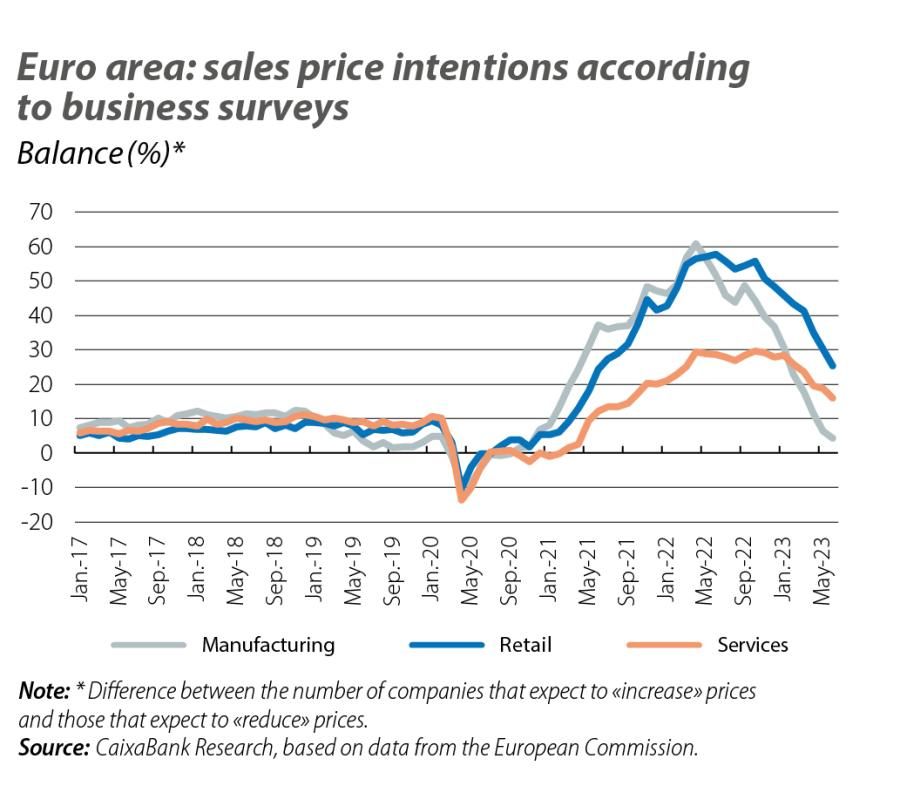European inflation: beginning of the end or end of the beginning?
Euro area inflation has been steadily declining for one clear reason: easing energy tensions. The question now is whether it will continue to fall rapidly towards 2% or whether it will encounter new pitfalls that hinder its downward path.

Euro area inflation has been steadily declining (–5 pps since it peaked last autumn) for one clear reason: energy. The pressure exerted by energy prices has faded with an intensity and speed commensurate with their escalation in 2022. The question now is whether inflation will continue to fall sharply towards the 2% target or whether, like a sailing boat that has been guided out of port, it will encounter new winds that will give it renewed momentum. In other words, with the easing of energy prices, are we witnessing the beginning of the end of inflation or are we embarking on a new chapter of lower inflation than in 2022 but with more resistance to further declines?
The analogy between inflation and sailing is not unfounded. As the first chart shows, in the beginning, inflation was essentially an energy matter: this component was responsible for 50% of total inflation and it exerted significant upward pressure throughout 2021 and 2022. In 2023, its direct contribution has fallen to zero, but it has left in its wake higher inflation in the rest of the consumer basket: food, goods and services.

The higher inflation in these components is largely an indirect effect of higher energy costs in the production of food, goods and services. Moreover, food and industrial goods have suffered their own tensions (war in Ukraine and global bottlenecks), which feed back into the prices of the other components. With the easing of energy and food prices in the international markets and the complete normalisation of the bottlenecks (since several months ago now), all these indirect effects are also fading. In fact, there are already signs of disinflation in the latest data. In May, inflation fell for all major components of the euro area’s HICP (with a synchrony not seen since 2013 and virtually continuing in June). In addition, the more «real-time» readings show inflation closer to the 3%-4% range than the 5%-6% indicated by the year-on-year measures (see second chart).1
- 1. In year-on-year terms, inflation reflects not only the growth of prices in the last month, but also that of the previous 11 months. In contrast, quarter-on-quarter or month-on-month inflation (when seasonally adjusted and annualised) offers a more recent (but also more volatile) indicator.

There is an entire other battery of prices which support this hypothesis of a moderation in inflation. Consumer prices, captured by the CPI, are the end result of a price formation chain. The indicators available along this chain are virtually all moving in a single direction: from companies’ own price-setting intentions (see third chart) to industrial production prices and farm-gate food prices (see fourth chart), we are seeing widespread disinflation consolidating across all sectors. Furthermore, as this disinflation filters into the final stages of the chain, in the coming quarters it will become more visible in consumer prices.


Therefore, assuming that energy and food prices continue to ease and global supply chains continue to function smoothly, the winds of inflation will shift to another trend: the pressure coming from margins and wages, in an effort to mitigate the loss of purchasing power that this past inflation has imposed on businesses and households. Given the greater intensity of the labour factor in services compared to goods, this component of the CPI could be more sensitive to these wage dynamics. However, services also suffer the lagging effect of the original winds (energy, food and bottlenecks), as reflected by components such as transport services, restaurants and hotels or maintenance and repair services.2 Like the rest of the basket of the consumer price index, prices in these types of services will lose momentum. Indeed, there are already signs of disinflation in various measures of underlying inflation (see fifth chart).
- 2. All of these categories have registered inflation of around 8% in recent months.

In parallel with the fading of the original winds, in the coming months disinflation will be accompanied by volatility, base effects and the new winds of margins and wages. Firstly, not only are there idiosyncratic factors that will generate some sporadic volatility (such as the transport subsidies in Germany),3 but the withdrawal of fiscal measures introduced to combat the energy crisis will have a significant base effect on euro area inflation: +0.5 pps in 2024, according to ECB estimates.4
The Chinese economy could also play a role. On the one hand, the abandonment of the zero-COVID policy will help prevent distortions in the global supply chain like those which stressed prices in 2021-2022. On the other hand, the strength of the initial revival of the Chinese economy raised fears of pressures on international commodity prices, but the latest data show a loss of momentum which could provide an additional respite for European inflation.
Finally, various studies point to the growing role of margins and wages.5 For monetary policy, one argument that offers some peace of mind regarding the role of margins is that their defence is limited by the strength of aggregate demand – and this looks set to diminish with the tightening of financial conditions.
As for wages, the available data suggest that, far from a spiral, they are following a pattern of growth which mitigates the loss of purchasing power. For instance, compensation per employee rose by 5.2% year-on-year in Q1 2023, accumulating 10% growth since Q4 2020. However, if we adjust this measure for inflation, this growth translates into a cumulative decline of 5%. For 2023, forecasts such as those of the ECB anticipate wage growth slightly above 5%, implying that real (i.e. inflation-adjusted) compensation per employee will remain 3% below the levels of prior to the war in Ukraine. In addition, the more up-to-date indicators such as the one produced by Indeed.com (see last chart) suggest that, beyond the «mitigating» wage rises of recent months, there is no new acceleration in wages. Against this figures, which are reasonably consistent with a scenario of gradual disinflation, monetary policy faces uncertainty over the future path of wages – an uncertainty which is accentuated by data showing employment at peak levels and unemployment at historic lows. The future is not yet written, but in the US, where the labour market has been clearly strained for some time and where wage growth has been slightly higher, studies suggest that the contribution of wages to CPI growth to date has been quantitatively modest.6
- 3. In particular, between June and August 2022, the German government launched a «9 euro ticket» that could be used to travel by bus and train throughout Germany. Between June and August 2023, this effect will work against the reduction in inflation and will be noticeable in the euro area as a whole (since Germany accounts for around 30% of the HICP).
- 4. ECB March 2023 macroeconomic projections.
- 5. See the recent entry on the IMF blog (26/06/2023), Europe’s Inflation Outlook Depends on How Corporate Profits Absorb Wage Gains.
- 6. See A.H. Shapiro (2023), «How Much Do Labor Costs Drive Inflation?», FRBSF Economic Letter, and B. Bernanke and O. Blanchard (2023), «What Caused the U.S. Pandemic-Era Inflation?» Hutchins Center Working Paper nº 86.

- 1. In year-on-year terms, inflation reflects not only the growth of prices in the last month, but also that of the previous 11 months. In contrast, quarter-on-quarter or month-on-month inflation (when seasonally adjusted and annualised) offers a more recent (but also more volatile) indicator.
- 2. All of these categories have registered inflation of around 8% in recent months.
- 3. In particular, between June and August 2022, the German government launched a «9 euro ticket» that could be used to travel by bus and train throughout Germany. Between June and August 2023, this effect will work against the reduction in inflation and will be noticeable in the euro area as a whole (since Germany accounts for around 30% of the HICP).
- 4. ECB March 2023 macroeconomic projections.
- 5. See the recent entry on the IMF blog (26/06/2023), Europe’s Inflation Outlook Depends on How Corporate Profits Absorb Wage Gains.
- 6. See A.H. Shapiro (2023), «How Much Do Labor Costs Drive Inflation?», FRBSF Economic Letter, and B. Bernanke and O. Blanchard (2023), «What Caused the U.S. Pandemic-Era Inflation?» Hutchins Center Working Paper nº 86.



